Nov 8th 2019 - Launch of FSD event
Return to BlogOur first blog is here!!!
Read about the official launch of our Food Smart Dublin project
by Cordula Scherer
On Thursday 10 Oct 2019 we launched our IRC funded COALESCE project Food Smart Dublin. The event was held at Trinity Long Room Hub under the auspices of the Trinity Centre for Environmental Humanities. As with all events like this there was quite a hectic, busy, but somewhat festive atmosphere from the early morning hours, shuffling chairs and putting up tables for everything to be tiptop. And unlike other official project launches this one was a different. We were going to serve seafood tasters that our project partner and chefs Niall Sabongi had cooked up from an old Irish recipe (from 1772). We were also going to serve carrageen (Irish moss) tea and freshly shucked native oysters.
Why?
Because our project aims to reintroduce forgotten seafood recipes to the Dublin diet. We want to bring back the intangible cultural heritage of preparing and eating local seafood in Dublin homes with the ultimate goal to make seafood consumption sustainable again.
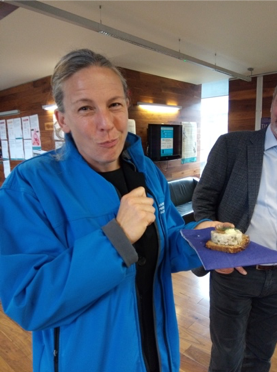
Susan Steele the CEO of the Sea Fisheries Protection Authority agreed to officially launch our project and showed up early apologising for the intrusion. I couldn’t have been happier to being able to chat with her one-to-one before everyone arrived. Our chat, even though, of short duration, inspired me. Susan even got a sneaky bite of the cod’s head terrine while Niall and his team were setting up. Unfortunately, she had to catch a flight right after the speeches and couldn’t stay on for the taster reception. Regina Sexton, professor for Irish food history at the University College Cork (UCC) also arrived in plenty of time giving her the chance to settle in before her talk on the history of seafood in Ireland. The room slowly started to fill up then and the event kicked off.
Susan Steele welcomed everyone and expressed her excitement about the project. She told the audience that in Ireland we suffer from something called “sea blindness”. She continued that for each acre of land we have 10 acres under the sea which makes Ireland’s the richest seas in Europe. But we don’t appreciate our waters enough. Instead we eat salmon, cod and tuna the tigers and lions of the sea since they are the top predators in the marine food web. Susan elaborated that with projects like this we get a chance to develop an appreciation of our rich and fertile seas again and rediscover our coastal cultural heritage once more. By eating local seafood from lower trophic levels we’re also able to address several UN sustainable development goals and the partnership with the food industry and an NGO enables research beyond the boundaries of academia.
Poul Holm picked up that it is the funding through the IRC COALESCE call that made this project and its framework possible. Being the arts and humanities PI of the project Poul expressed his excitement about it, because it isn’t just “talk”, but “Do”. He continued that with our fantastic partners Niall Sabongi and ECO-UNESCO we can actually try it out for real as they provide the entry points to practise. As a marine environmental historian Poul knows that the next generation will experience a dramatic reduction of our current seafood consumption. He continued that it will go down to 11 kg per capita in 2030 if we continue to eat the tigers and lions of the ocean. We are facing an ocean crisis and unless we’re changing our consumption habits this crisis will escalate!
Nessa O’Connor, coastal biologist and co-PI of the FSD project emphasised that we must apply the knowledge of coastal cultural heritage and environmental humanities to improve our understanding of the marine ecosystems today. She continued that the knowledge we gain from history will help us to improve our prediction models and that it is the ideal framework for merging the arts and humanities and the natural sciences. Nessa highlighted further that it is equally important to know what oysters, mussels, seaweeds are, why they grow and where, the habitats they provide, their ecosystem services and the food they eat. She expressed her excitement about working on the project and about trying all the recipes that are going to be cooked up.
I gave a detailed presentation on the project itself being its natural sciences post-doc. Then our partners introduced themselves. Elaine Nevin, the director of eco-unesco, Ireland’s environmental education and youth organisation explained that she is keen to channel the passion of the youth towards taking environmental action. The NGO came on board, because they saw a great opportunity to educate the youth about where their food comes from and what the consequences of consumption are.
Niall Sabongi went on this path of chef, restaurateur, seafood wholesaler, because he always felt restricted in eating and sourcing seafood in Dublin. His aim is to make seafood more accessible and to introduce seasonality into our seafood diets again! Niall’s mission is as he often says “to slap the “posh” out of seafood and remind the Irish people of the island nation we are”. Niall got excited when he mentioned the historical recipes and said that he is up for the challenge to reinvent old recipes for the modern pallet.
Our invited speakers Regina Sexton (UCC) and Máirtín Mac Con Iomaire were up next being very complimentary about Food Smart Dublin. Regina pointed out that it is the right time to investigate the Irish historical food culture. She continued to say that the interdisciplinarity of the project is very important and possibly the essence for its success. She further knew from her own experience that great obstacles have to be overcome in the sense of squeamishness of the Irish people eating other parts of the fish but the fillets. Regina gave us a little teaser and treat at the same time when she presented an image of the original recipe that Niall turned into a cod’s head terrine from the NLI Townley papers, 1772.
Máirtín gave us a great taster of (sea)food lyrics making us discover the rich ancient Irish food culture still manifested in many place names such as Leixlip (lachs slip, salmon slip); South Dublin Glenageary – valley of the sheep; Clontarf – meadow of the bulls. He even recited Jonathan Swift’s herrings poem which goes like this:
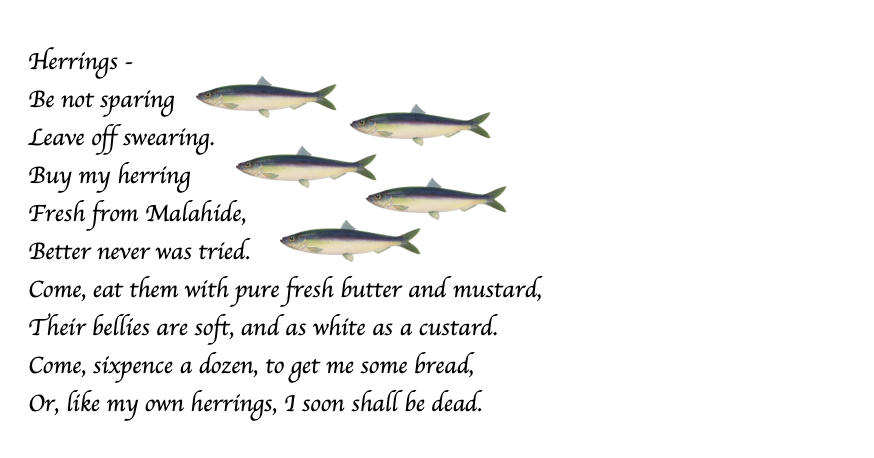
What a wonderful performance!
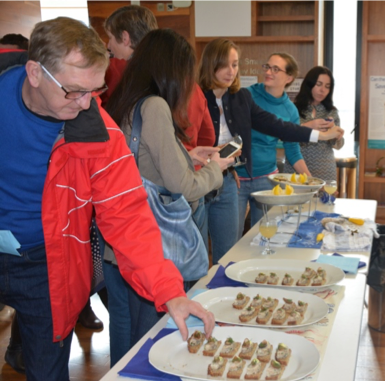
We were ready for the seafood reception then. Beautifully arranged fresh oysters and the cod’s head terrine as well as carrageen tea were waiting for us.
The atmosphere was relaxed and cheery, people mingled having the terrine in one hand and the tea in the other. The oyster lovers amongst the attendees kept going back to indulge on that beautiful fresh flesh and Niall and his team had to work hard to keep up with all the shucking.

Then it was my turn to eat my first ever oyster – a native one from Connemara. Having been shown how to shuck them by the man himself, I was hoping I could get away with shucking a few of them instead, but Niall had me there and then and peer-pressure is a beautiful thing along with cameras and spectators watching. So I followed his instruction to taste the sea water first to stimulate my pallets – then not to swallow the whole thing in one go to avoid gaging, but to bite it at least ones on each site explaining that our mouth has different taste buds on the left and right – one side is for sweet stuff the other more for the savoury taste. So I bit ones on each site and ones in the front, just in case, and swallowed … it felt like I got a refreshing slap of seawater in my face. Wow – I didn’t expect that!
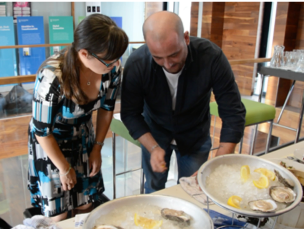
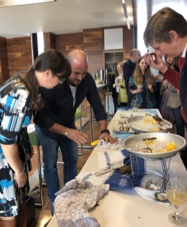
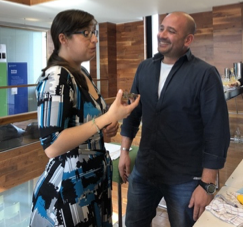
Both our PI's were totally into it too, but I must say the cod’s head terrine was just divine!
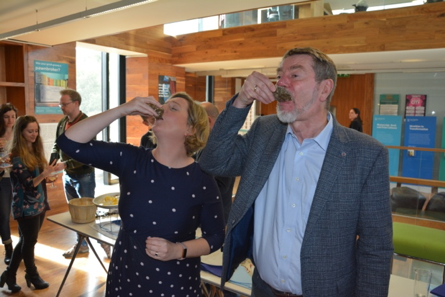
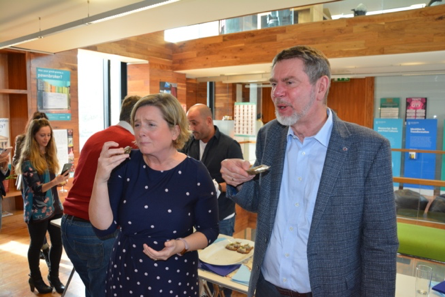
The twitter feeds after our launch were mighty. It seemed that everyone really enjoyed themselves drinking carrageen tea and eating the fresh native oysters and cod head terrine skilfully served by the brilliant Niall and his team from the Seafood Cafe.
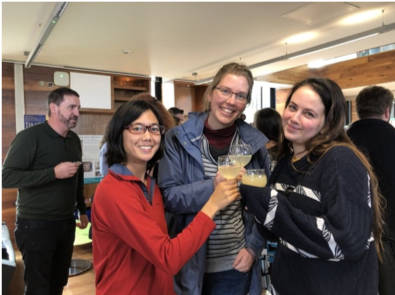
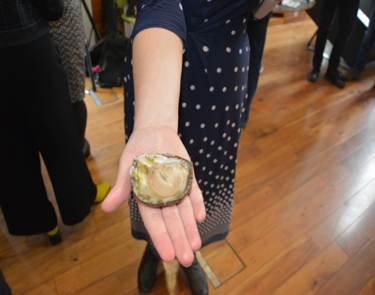
Who would’ve thought that the craic can be so mighty at a project launch about coastal cultural heritage and sustainable, local seafood?
There’s more to come so watch this space…!

